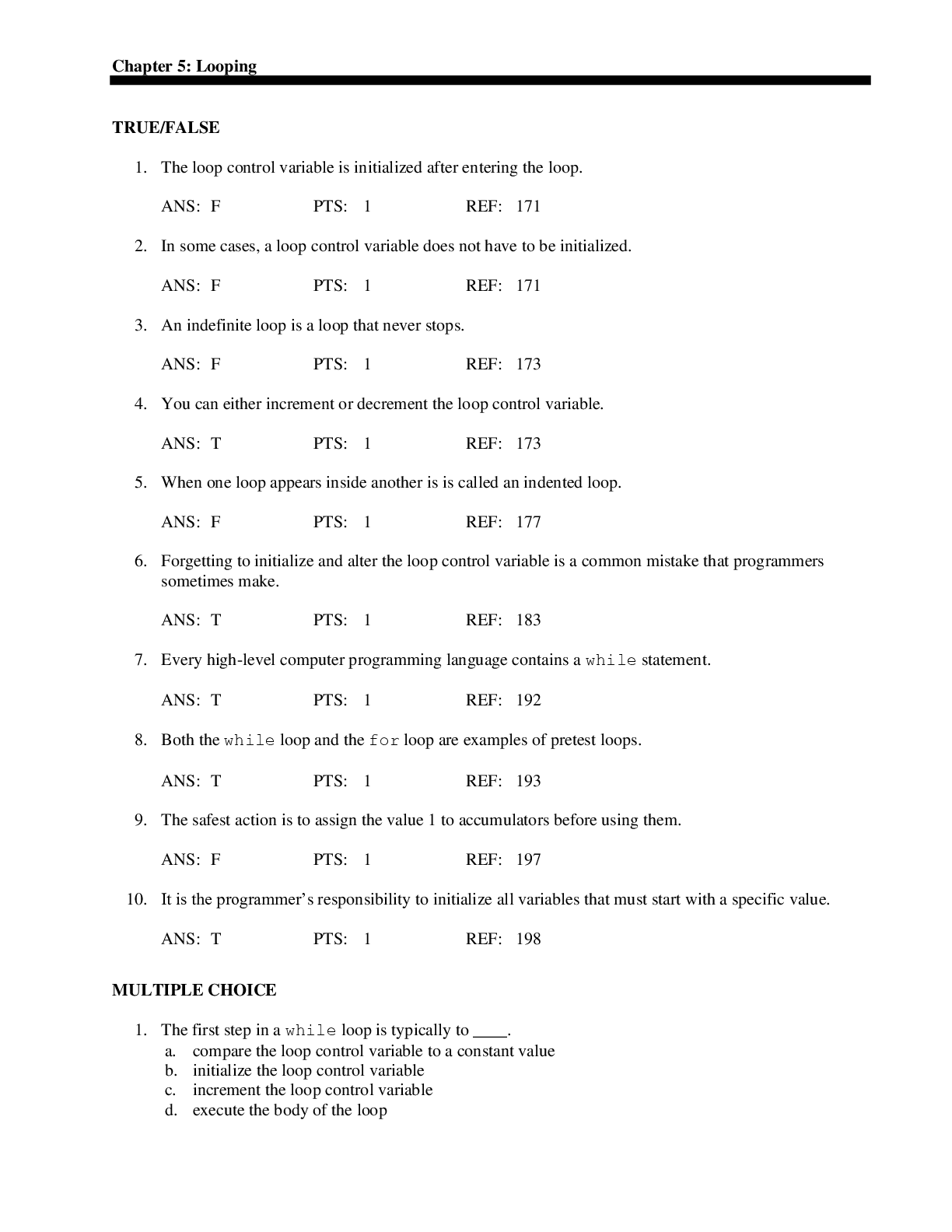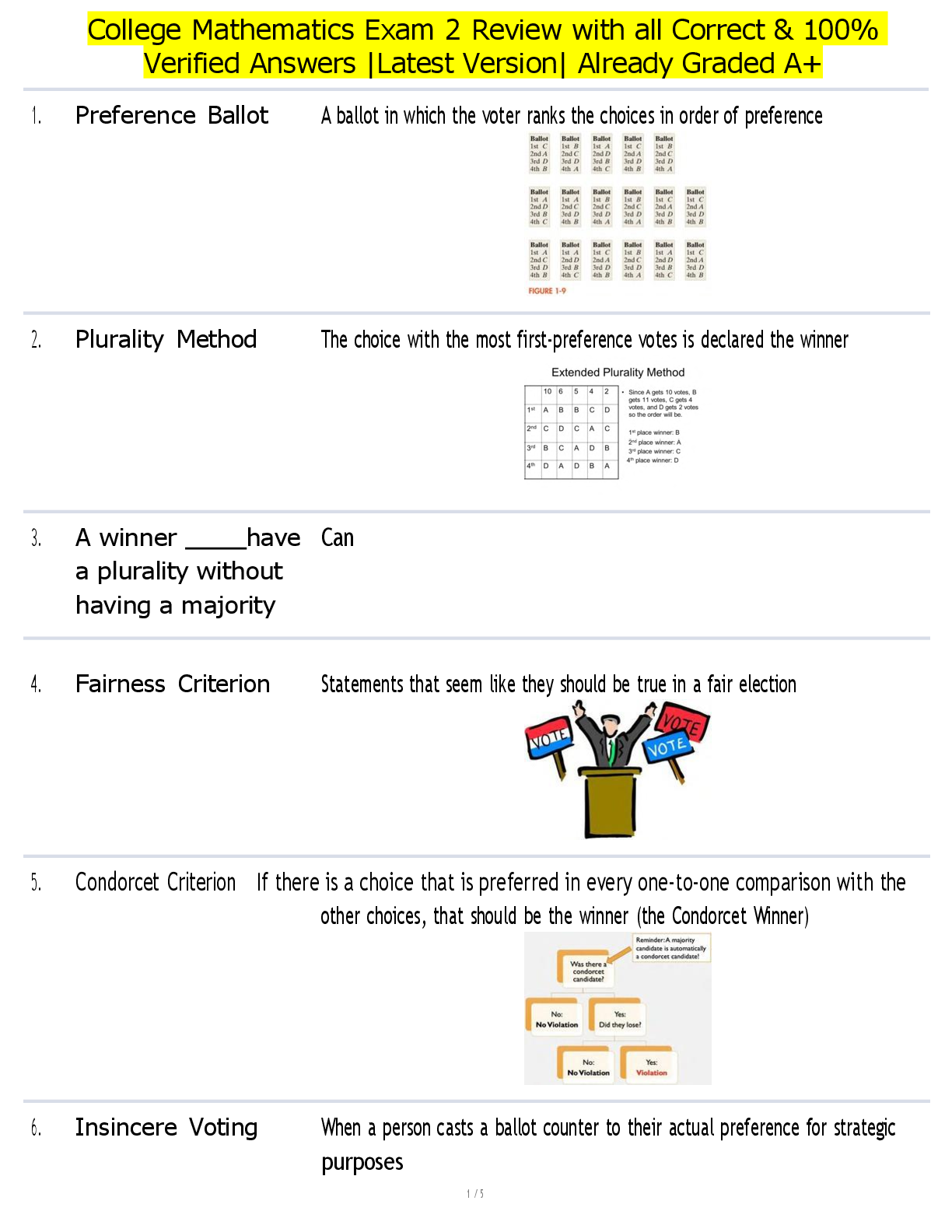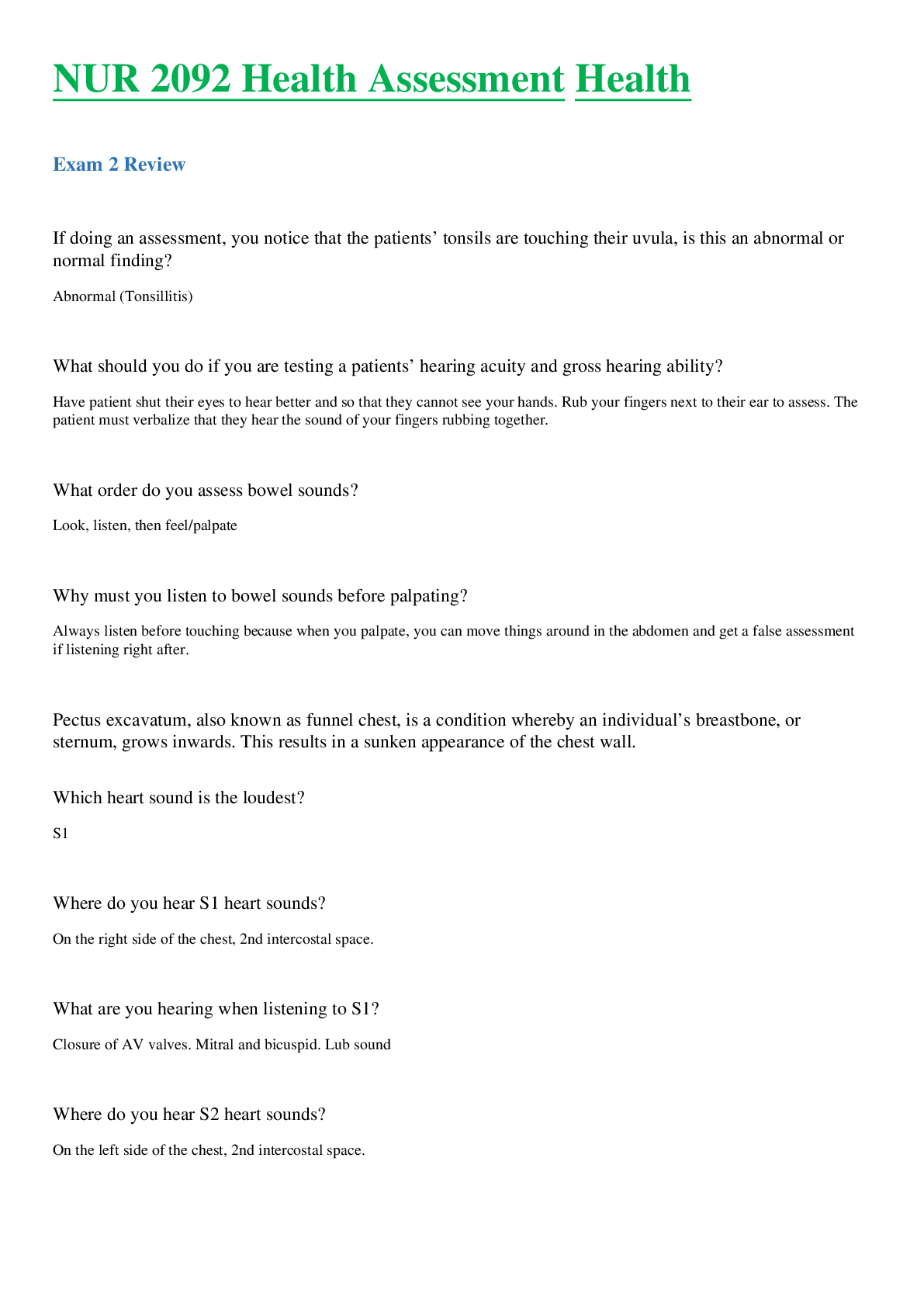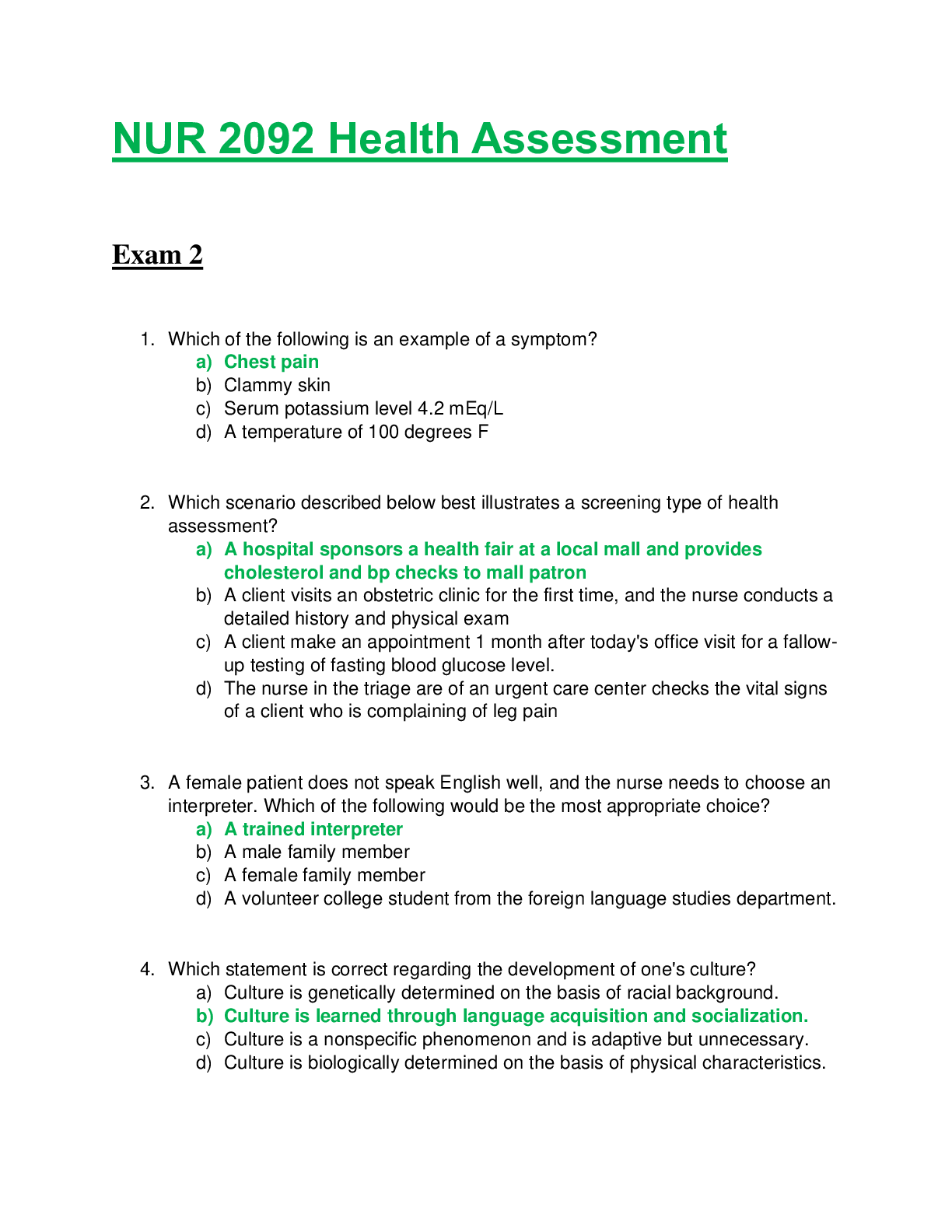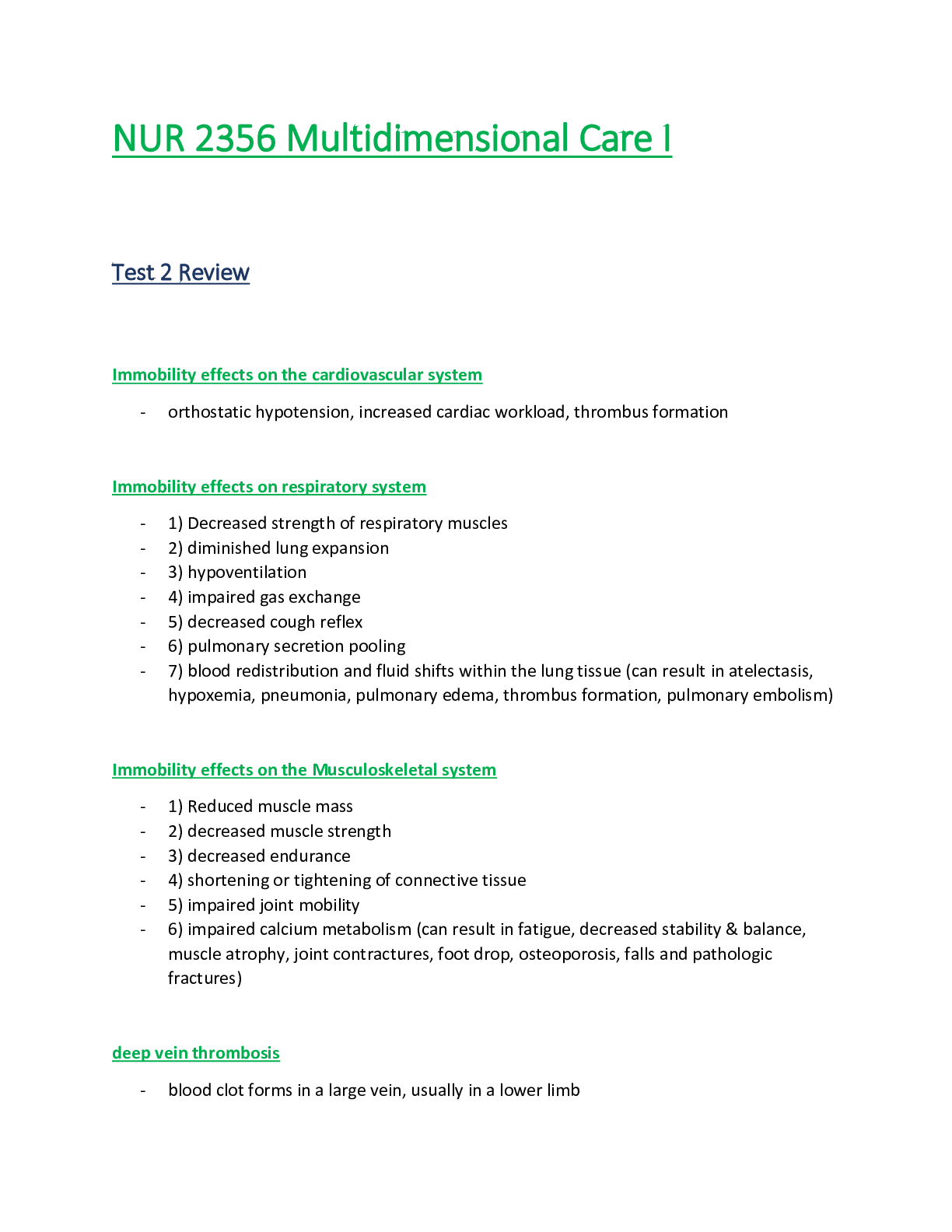Medicine > EXAM REVIEW > (IBCLC) Certification Exam Review Solutions / IBCLC Exam Review Complete_ . Distinction Level Revie (All)
(IBCLC) Certification Exam Review Solutions / IBCLC Exam Review Complete_ . Distinction Level Review Has everything.
Document Content and Description Below
(free Sample) IBCLC Exam % of breastmilk that is carbohydrates ✓- Approximately 7% Wikipedia. en.wikipedia.org/wiki/Breast_milk. % of breastmilk that is fat ✓- Approximately 4% Hale and Hart ... man, 2007. Textbook of Human Lactation, page 50. % of breastmilk that is protein ✓- Approximately .8 - 1 % Mannel, Martens & Walker, 2008. Core Curriculum for Lactation Consultant Practice (2nd ed.), page 272. % of calories in breastmilk from carbohydrates ✓- Approximately 40% Hale and Hartman, 2007. Textbook of Human Lactation, page 69. % of calories in breastmilk from fat ✓- Approximately 50% Riordan & Wambach, 2010. Breastfeeding and Human Lactation (4th ed.), page 124. % of calories in breastmilk from protein ✓- Approximately 10% Mannel, Martens & Walker, 2008. Core Curriculum for Lactation Consultant Practice (2nd ed.), page 272. Acinus ✓- Any of the small sacs or alveoli that terminate the ducts and are lined with secretory cells. Merriam-Webster Medical Dictionary. Available online: http://www.merriam-webster.com/medical/acinus?show=0&t=1296699192 Acrocyanosis ✓- Bluish discoloration of the hands and feet in the newborn; peripheral cyanosis. Should not persist beyond 24 hours after birth. Riordan & Wambach, 2010. Breastfeeding and Human Lactation (4th ed.), page 863. Active immunity ✓- Immunity conferred by the production of antibodies by one's own immune system. Riordan & Wambach, 2010. Breastfeeding and Human Lactation (4th ed.), page 868. Active transport ✓- Passage of drug into breastmilk assisted by components in breastmilk. Hale & Hartman, 2007. Textbook of Human Lactation, page 470. Acyclovir/Zovirax ✓- Antiviral used to treat herpes infections, L2. Riordan & Wambach, 2010. Breastfeeding and Human Lactation (4th ed.), page 177. Aerobic bacteria ✓- Bacteria requiring air for metabolic processes. The breast is colonized with this type of bacteria. Riordan & Wambach, 2010. Breastfeeding and Human Lactation (4th ed.), page 863. AGA ✓- Appropriate for Gestational Age. Having a birth weight between the 10th and 90th percentile on intrauterine growth charts. Riordan & Wambach, 2010. Breastfeeding and Human Lactation (4th ed.), page 671. Alcohol and breastfeeding ✓- Alcohol can decrease milk supply. Breastfeeding must be interrupted for 1 hour per drink, or until mother is sober. Riordan & Wambach, 2010. Breastfeeding and Human Lactation (4th ed.), page 171 & 188. Aldomet/Methyldopa ✓- Antihypertensive, L2. Frequently used to treat hypertension during pregnancy. No concerns reported via breastmilk. Hale, 2010. Medications and Mother's Milk (14th ed.), page 667. Allergen ✓- A substance that causes an allergic response, such as foods, drugs, inhalants. Cow's milk is common source for infants. Riordan & Wambach, 2010. Breastfeeding and Human Lactation (4th ed.), page 863. Αlphalactalbumin ✓- A major protein found in human milk whey. Assists in processing lactose. Riordan & Wambach, 2010. Breastfeeding and Human Lactation (4th ed.), page 863. Alveolar ridge ✓- The ridges on the upper and lower jaw where infant's teeth will grow. Riordan & Wambach, 2010. Breastfeeding and Human Lactation (4th ed.), page 863. Alveolus, alveoli ✓- Secrete and store milk for let down. Surrounded by myoepithelial cells, contractile cells and connective tissue. Riordan & Wambach, 2010. Breastfeeding and Human Lactation (4th ed.), page 80. Amenorrhea ✓- A natural phase of infertility that takes place when a mother is exclusively breastfeeding. Menstruation has not returned. Riordan & Wambach, 2010. Breastfeeding and Human Lactation (4th ed.), page 707 &865. Amoxicillin ✓- Antibiotic, L2. Observe for change in intestinal flora, compatible. Riordan & Wambach, 2010. Breastfeeding and Human Lactation (4th ed.), page 177. Ampicillin ✓- Antibiotic, L1. Observe for change in intestinal flora, compatible. Riordan & Wambach, 2010. Breastfeeding and Human Lactation (4th ed.), page 177. Anaphylaxis ✓- Hypersensitivity (as to foreign proteins or drugs) resulting from sensitization following prior contact with the causative agent. Merriam-Webster Medical Dictionary. www.merriam-webster.com/medical/anaphylaxis. Anchor scar ✓- Surgical technique for breast reduction, slang. Ankyglossia ✓- A tongue tie. Characterized by a thick, short, or tight frenulum under the tongue. Can cause breastfeeding issues, such as a painful latch or inefficient milk transfer. Anterior pituitary ✓- This gland releases prolactin into the blood effecting milk production and ejection. It is susceptible to stress. Riordan & Wambach, 2010. Breastfeeding and Human Lactation (4th ed.), page 91. Anthrax ✓- Infectious disease caused by a spore-forming bacterium (Bacillus anthrax), characterized by external ulcerating nodules or by lesions in the lungs. Merriam Webster Medical Dictionary. www.merriam-webster.com/medical/anthrax. Antibody ✓- Immunoglobulin formed in response to an antigen, including bacteria and viruses. Antibodies attack those bacteria or viruses helping the body resist infection. Riordan & Wambach, 2010. Breastfeeding and Human Lactation (4th ed.), page 863. Antigen ✓- Substance that stimulates antibody production. May be dust, food, or bacteria. Riordan & Wambach, 2010. Breastfeeding and Human Lactation (4th ed.), page 863. Apgar score ✓- Index to evaluate the condition of a newborn infant based on a rating of 0, 1, or 2 for color, heart rate, reflex response, muscle tone, and respiration with 10 being a perfect score. Merriam-Webster Medical Dictionary. www.merriam-webster.com/medical/apgar%20score. Apocrine gland ✓- Sweat glands located on the areola that secrete a scent. Mannel, Martens & Walker, 2008. Core Curriculum for Lactation Consultant Practice (2nd ed.), page 197-198. Apoptosis ✓- Programmed normal cell death. Riordan & Wambach, 2010. Breastfeeding and Human Lactation (4th ed.), page 863. Applied research ✓- Research that focuses on solving or finding an answer to a clinical or practical problem. Riordan & Wambach, 2010. Breastfeeding and Human Lactation (4th ed.), page 863. Areola ✓- The darker pigmented skin that surrounds the nipple. Contains sebaceous glands (Montgomery Glands) Riordan & Wambach, 2010. Breastfeeding and Human Lactation (4th ed.), page 863. Aspirin ✓- Salicylate analgesic, L3. Use associated with Reye's Syndrome in infants. Hale, 2010. Medications and Mother's Milk (14th ed.), page 87. Atopic eczema ✓- Inherited allergic tendency to skin rashes or inflammation. Exclusively breastfed infants are less likely to develop as cow's milk protein is a common allergen. Riordan & Wambach, 2010. Breastfeeding and Human Lactation (4th ed.), page 863. Autocrine control ✓- The point in lactation when milk supply is controlled by milk removal. Local control in the breast. Riordan & Wambach, 2010. Breastfeeding and Human Lactation (4th ed.), page 92. Autonomy ✓- The capacity of a rational individual to make an informed, un-coerced decision. Wikipedia. en.wikipedia.org/wiki/Autonomy#Medicine. Average ✓- The middle value of a data set. Add all the numbers and divided by the amount of numbers in the set. Wikipedia. Available online: http://en.wikipedia.org/wiki/Average. Axilla ✓- Underarm. Breast tissue (the axillary tail) can sometimes extend into axilla. Riordan & Wambach, 2010. Breastfeeding and Human Lactation (4th ed.), page 863-864. B Cell ✓- Lymphocyte produced in bone marrow and peripheral lymphoid tissue; found in breastmilk. Attacks antigens. Riordan & Wambach, 2010. Breastfeeding and Human Lactation (4th ed.), page 864. β lactaglobin ✓- Major protein in bovine milk. Hale & Hartman, 2007. Textbook of Human Lactation, page 40. Back to sleep ✓- A campaign that significantly reduced SIDS. Babies are less prone to SIDS when sleeping on their back. Mannel, Martens & Walker, 2008. Core Curriculum for Lactation Consultant Practice (2nd ed.), page 632. Bactericidal ✓- Destroys bacteria. Merriam-Webster Medical Dictionary. www.merriam-webster.com/medical/bactericidal. Bacteriostatic ✓- Prevents the growth of bacteria. Riordan & Wambach, 2010. Breastfeeding and Human Lactation (4th ed.), page 864. Bactrim/Septra ✓- Sulfonamide antibiotic, L3. The mixture of trimethoprim and sulfamethoxazole. No concerns reported via breastmilk. Hale, 2010. Medications and Mother's Milk (14th ed.), page 249. BALT/GALT/MALT ✓- Bronchus/gut/mammary-associated immunocompetent lymphoid tissue. Intermammary pathway. IgA antibodies are transferred through breastmilk to the infant. Riordan & Wambach, 2010. Breastfeeding and Human Lactation (4th ed.), page 864. Basic research ✓- Research that generates knowledge for the sake of knowledge. Riordan & Wambach, 2010. Breastfeeding and Human Lactation (4th ed.), page 864. Bed-sharing ✓- Sharing adult bed with baby. Questioned safety in reduction of SIDS. Safe bed sharing has been shown to extend the duration of breastfeeding. Riordan & Wambach, 2010. Breastfeeding and Human Lactation (4th ed.), page 282-283. Bellagio Consensus Conference ✓- Meeting to develop protocol for the Lactational Amenorrhea Method of birth control. 1988. Riordan & Wambach, 2010. Breastfeeding and Human Lactation (4th ed.), page 714-715. Beneficence ✓- The duty to do good. Riordan & Wambach, 2010. Breastfeeding and Human Lactation (4th ed.), page 31. BFHI Baby Friendly Hospital Initiative ✓- Initiative by UNICEF and WHO (1991) to support breastfeeding in hospitals and maternity centers. "The 10 Steps". Unicef. Baby-Friendly Hospital Initiative. Available online: http://www.unicef.org/programme/breastfeeding/baby.htm. Bioavailable ✓- The amount of a nutrient that is actually absorbed by the body. Nutrients found in breastmilk are easily absorbed by the infant's body. Riordan & Wambach, 2010. Breastfeeding and Human Lactation (4th ed.), page 864. Bisphenol A ✓- (BPA) organic compound found in plastics. Linked to disease in infants. Now banned. (BPA) organic compound found in plastics. Linked to disease in infants. Now banned. Bivariate ✓- Statistics derived from the analysis of the relationship between two variables. Riordan & Wambach, 2010. Breastfeeding and Human Lactation (4th ed.), page 864. Blessed thistle ✓- An herbal galactagogue. L3. Walker, 2009. Breastfeeding Management for the Clinician: Using the Evidence (2nd ed.), page 592. Bolus ✓- A quantity of medication given by IV, or a quantity of fluid (milk) given orally. Merriam-Webster Medical Dictionary. www.merriam-webster.com/medical/bolus. Bradycardia ✓- Relatively slow heart rate. Opposite of tachycardia. Merriam Webster Medical Dictionary. www.merriam-webster.com/medical/bradycardia. Breastfeeding dyad ✓- A breastfeeding mother and baby. Buccal pads ✓- Fat pads on the masseter muscles in an infant's cheeks giving them a plump cheeked appearance. Provide stability for the tongue during suckling. Riordan & Wambach, 2010. Breastfeeding and Human Lactation (4th ed.), page 864. Calories in breastmilk ✓- Mature milk has approximately 20 cal/oz. Mannel, Martens & Walker, 2008. Core Curriculum for Lactation Consultant Practice (2nd ed.), page 227. Candidiasis ✓- Fungal infection caused by Candida albicans; also called "thrush." Riordan & Wambach, 2010. Breastfeeding and Human Lactation (4th ed.), page 864. Caput succedaneum ✓- Diffuse swelling or collection of serum under the scalp of the newborn from birth trauma. Differentiated from cephalhematoma by unrestriction by the sutures of the skull. Riordan & Wambach, 2010. Breastfeeding and Human Lactation (4th ed.), page 864. Casein ✓- The main protein in breastmilk. Creates the curd when digested in the infant stomach. Riordan & Wambach, 2010. Breastfeeding and Human Lactation (4th ed.), page 864. Walker, 2009. Breastfeeding Management for the Clinician: Using the Evidence (2nd ed.), page 26. Central pedicle technique ✓- Breast reduction surgical technique. Intended to keep ducts intact. Mannel, Martens & Walker, 2008. Core Curriculum for Lactation Consultant Practice (2nd ed.), page 654. Cephalexin/Keflex ✓- Antibiotic, L1. Observe for change in intestinal flora; compatible. Riordan & Wambach, 2010. Breastfeeding and Human Lactation (4th ed.), page 178. Cephalhematoma ✓- Collection of blood beneath the periosteum due to birth trauma; contrasted with caput succedaneum, where the effusion overlies the periosteum and consists of serum. Riordan & Wambach, 2010. Breastfeeding and Human Lactation (4th ed.), page 864. Chamomile ✓- A herb, L3. Used for anti-inflammatory, calminative, antispasmodic, milk sedative, and antiseptic properties. No concerns reported via breastmilk. Hale, 2010. Medications and Mother's Milk (14th ed.), page 202. Chicken pox ✓- A virus infection, mothers can continue to breastfeed. Antibodies from her breastmilk provides immunity for the baby. Riordan & Wambach, 2010. Breastfeeding and Human Lactation (4th ed.), page 202-203. Chi-square ✓- Statistical procedure that uses nominal level data and determines significant differences between observed frequencies in relation to data and expected frequencies. Riordan & Wambach, 2010. Breastfeeding and Human Lactation (4th ed.), page 864. Choanal atresia ✓- A rare congenital anomaly, blocked posterior nostrils on one or both sides. Feedings by mouth are either difficult or impossible. Surgery opens the airways. Riordan & Wambach, 2010. Breastfeeding and Human Lactation (4th ed.), page 644. Chylothorax ✓- Congenital anomaly, obstruction of the lymphatic system. Chyle (lymphatic fluid) collects in the chest cavity and is drained via chest tubes. Managed by diet and medication. Fat free breastmilk has been used successfully. Riordan & Wambach, 2010. Breastfeeding and Human Lactation (4th ed.), page 648-649. Ciprofloxacin (Cipro) ✓- Antibiotic, L3. Recently approved by AAP. Riordan & Wambach, 2010. Breastfeeding and Human Lactation (4th ed.), page 178. Hale, 2010, Medications in Mothers' Milk. p. 224. Claritin/Loratadine ✓- Long-acting antihistamine, L1. Observe for sedation, dry mouth, and tachycardia. Hale, 2010. Medications and Mother's Milk (14th ed.), page 617. CMV Cytomegalovirus ✓- Type of herpes virus found in human milk, genital tract, urine, and pharynx. Transmitted by close contact. Avoid pumping or breastfeeding in premature infants if mom has acute infection. Riordan & Wambach, 2010. Breastfeeding and Human Lactation (4th ed.), page 204. Colic ✓- Syndrome in early infancy characterized by episodic loud crying, apparent abdominal pain (legs drawn up and rigid abdomen) and irritability. Riordan & Wambach, 2010. Breastfeeding and Human Lactation (4th ed.), page 864-865. Colostrum ✓- First milk created during late pregnancy and early postpartum period. Has higher concentrations of immunoglobins, fat soluble vitamins and some minerals. Riordan & Wambach, 2010. Breastfeeding and Human Lactation (4th ed.), page 865. Comfrey ✓- An herbal poultice, L5. Is not considered safe due to alkaloids found in breastmilk after use. Hale, 2010. Medications and Mother's Milk (14th ed.), page 259. Conceptual framework ✓- Structure of interrelated concepts that may be generated inductively by qualitative research to provide a base for quantitative study. Riordan & Wambach, 2010. Breastfeeding and Human Lactation (4th ed.), page 865. Congenital infection ✓- Infection existing at birth that was acquired via placenta. Includes HIV and TORCH organisms. Riordan & Wambach, 2010. Breastfeeding and Human Lactation (4th ed.), page 865. Conjunctivitis ✓- Inflammation of the mucous membrane that lines the eyelid. Sometimes treated with fresh breastmilk. Riordan & Wambach, 2010. Breastfeeding and Human Lactation (4th ed.), page 865. Construct ✓- Higher order theoretical or empirical idea or phenomenon that has abstract meaning and requires multiple concepts to represent it more concretely. Riordan & Wambach, 2010. Breastfeeding and Human Lactation (4th ed.), page 865. Contraception ✓- Preventing conception. Hormonal pill, barrier methods, intrauterine device. Breastfeeding can provide contraceptive protection. Riordan & Wambach, 2010. Breastfeeding and Human Lactation (4th ed.), page 865. Cooper's ligaments ✓- Also know as the "suspensory ligaments." Attaches the skin of the breast to the chest wall. Riordan & Wambach, 2010. Breastfeeding and Human Lactation (4th ed.), page 82. Cord blood ✓- Blood remaining in the umbilical cord after birth. May be saved for later stem cell transplantation. Riordan & Wambach, 2010. Breastfeeding and Human Lactation (4th ed.), page 865. Correlation coefficient ✓- Statistic that indicates the degree of relationship between two variables. The range in value is +1.00 to -1.00; 0.0 indicates no relationship, +1.00 is a perfect positive relationship, and -1.00 is a perfect inverse relationship. Riordan & Wambach, 2010. Breastfeeding and Human Lactation (4th ed.), page 865. Creamotcrit ✓- The amount of cream in a milk sample. The amount of cream (fat) varies from mother to mother, feeding to feeding, and throughout the course of lactation. Riordan & Wambach, 2010. Breastfeeding and Human Lactation (4th ed.), page 865. Cross-nursing ✓- Informal, short term wet nursing. Typically seen in the context of child care. Riordan & Wambach, 2010. Breastfeeding and Human Lactation (4th ed.), page 865. Cultural competency ✓- Ability to understand, communicate, and interact effectively with people from different cultures. Four components: Awareness of one's own cultural worldview; attitude towards cultural differences; knowledge of different cultural practices and worldviews; cross-cultural skills. Wikipedia. en.wikipedia.org/wiki/Cultural_Competency. Cultural relativism ✓- Acknowledging the variation in beliefs and actions given to the behaviors of different cultures. Riordan & Wambach, 2010. Breastfeeding and Human Lactation (4th ed.), page 865. Culture ✓- The values, beliefs, norms, and practices shared by a group of people that guide the thoughts and behaviors of that group. Riordan & Wambach, 2010. Breastfeeding and Human Lactation (4th ed.), page 865. Cyanotic/Cyanosis ✓- Bluish coloring due to low oxygen levels. Mannel, Martens & Walker, 2008. Core Curriculum for Lactation Consultant Practice (2nd ed.), page 296-296. Cytoprotective ✓- Protection from inflammation and death for cells. Riordan & Wambach, 2010. Breastfeeding and Human Lactation (4th ed.), page 854. De- ✓- Latin word meaning "of" or "from." Wikipedia. Available online: http://en.wikipedia.org/wiki/De. Deductive reasoning ✓- Process of reasoning from a general premise to the concrete and specific. Riordan & Wambach, 2010. Breastfeeding and Human Lactation (4th ed.), page 865. Deontology ✓- Approach to ethics that judges the morality of an action based on the action's adherence to rules. Described as duty or obligation, because rules 'binds you to your duty'. Wikipedia. Available online: http://en.wikipedia.org/wiki/Deontology. Dependent variable ✓- Variable the investigator measures in response to the independent or treatment variable; the outcome variable that is affected by the independent variable. Riordan & Wambach, 2010. Breastfeeding and Human Lactation (4th ed.), page 865. DHA & ARA ✓- Docosahexanoic acid and Arachidonic acid. Essential fatty acids known for improving visual acuity and cognitive ability. Riordan & Wambach, 2010. Breastfeeding and Human Lactation (4th ed.), page 125-126. Diffusion ✓- Process by which the molecules of one substance (e.g., a drug) are spread uniformly throughout blood or plasma. Riordan & Wambach, 2010. Breastfeeding and Human Lactation (4th ed.), page 866. Dioxin ✓- Chemical contaminant in the environment. As dioxin levels increase, the EPA has still determined it safe for mothers to breastfeed in the United States. Mannel, Martens & Walker, 2008. Core Curriculum for Lactation Consultant Practice (2nd ed.), page 369. Disaccharide ✓- Complex sugar consisting of two monosaccharides. Forms the principle sugar in breastmilk, known as lactose. Riordan & Wambach, 2010. Breastfeeding and Human Lactation (4th ed.), page 866. Distal ✓- Remote from the point of attachment or origin. Opposite of proximal. Wikitionary. Available online: http://en.wiktionary.org/wiki/distal. Dong quai ✓- Herb contraindicated in lactation. Used to quell uterine cramps. Humphrey, 2003. The Nursing Mother's Herbal, page 239. Donor milk ✓- Human milk voluntarily given to a milk bank. Donor is screened, milk is pasteurized. Riordan & Wambach, 2010. Breastfeeding and Human Lactation (4th ed.), page 866. Dopamine ✓- A prolactin inhibiting factor. Decrease releases prolactin and milk production begins. Riordan & Wambach, 2010. Breastfeeding and Human Lactation (4th ed.), page 88. Down Syndrome ✓- Duplication of the 21st chromosome. Characterized by epicanthal folds, a flat nasal bridge, broad hands and short fingers, a single crease in the upper palm (simian crease), a flattened forehead, small mouth, large tongue (macroglossia), and hypotonia. Some have congenital heart disease. Riordan & Wambach, 2010. Breastfeeding and Human Lactation (4th ed.), page 636. DRGs ✓- Diagnostic Related Groups, used by insurance companies for reimbursement. Diagnostic Related Groups, used by insurance companies for reimbursement. Wikipedia. en.wikipedia.org/wiki/Diagnosis-related_group. Drip milk ✓- Milk that leaks from the opposite breast during a feeding. This milk is low in fat. Riordan & Wambach, 2010. Breastfeeding and Human Lactation (4th ed.), page 866. Ductules ✓- The small ducts in the mammary gland that transfer the milk from the alveoli to the lactiferous ducts. Riordan & Wambach, 2010. Breastfeeding and Human Lactation (4th ed.), page 866. Echinacea ✓- Herbal immunostimulant, L3. Known for stimulating immune system and wound healing. No concerns reported via breastmilk. Hale, 2010. Medications and Mother's Milk (14th ed.), page 348. Eczema ✓- A skin inflammation or rash. Riordan & Wambach, 2010. Breastfeeding and Human Lactation (4th ed.), page 866. Eminences of the pars villosa ✓- "Tiny swellings on the inner surfaces of the infant's lips that help the infant to retain a grasp on the breast during suckling." Riordan & Wambach, 2010. Breastfeeding and Human Lactation (4th ed.), page 866. [Show More]
Last updated: 3 years ago
Preview 1 out of 43 pages

Buy this document to get the full access instantly
Instant Download Access after purchase
Buy NowInstant download
We Accept:

Reviews( 0 )
$17.50
Can't find what you want? Try our AI powered Search
Document information
Connected school, study & course
About the document
Uploaded On
Apr 28, 2022
Number of pages
43
Written in
All
Additional information
This document has been written for:
Uploaded
Apr 28, 2022
Downloads
0
Views
127



